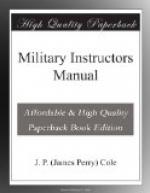Report.—1. Do not report the
presence of small patrols unless you
have been ordered to do so. Locate the main body
or a large command.
2. Determine his strength,
kind of troops and movements.
3. Remember the indispensable
qualities of a report are: accuracy
as to facts, simplicity,
clearness, legibility and correct
spelling.
Surmises must not be given as facts. Separate
what you
know and what
has been told you. A report should not be
expressed carelessly
in ten words when it could be clearly
stated in twenty.
Send a sketch if practicable.
4. Do not send a verbal message.
5. Address it to C.O.
Support or C.O. Advance Guard, etc., not
to
the commander
of a certain body of troops. Give date, place
and
time.
6. Remember to state what you
intend to do.
7. In hostile country send
two messages by different routes. In
friendly country
one will suffice.
8. When the capture of your
message is likely, give messenger a
false one that
will be easily found and conceal the true message
carefully.
Return.—1. Do not return over
the same route as you avoid ambuscade
and widen your field of reconnaissance.
2. Report any special features
of military value that you have
seen to your C.O.
3. Compliment your men.
(j) Advance Guard.—“An advance guard is a detachment of the main body which precedes it and covers it on the march” (i.d.r. 639). The commander of troops designates the advance guard, the distance between it and the main body, and also designates a commander. The advance guard commander if he has more than a battalion designates the reserve, support, distance between them. If the advance guard is a battalion or less it would have no reserve, and in that case the advance guard commander would designate the support, advance party, and the distance between them. In the former case the support commander would designate the advance party, and the distance between the support and the advance party. In both cases the advance party commander designates the point, and the distance between the point and the advance party. Usually it is the duty of the advance party to send out flank patrols. The strength varies from 1/20 to 1/3 of the main body. Remember “the formation of the advance guard must be such that the enemy will first be met by a patrol, then in turn by one or more larger detachments, each capable of holding the enemy until the next in rear has time to deploy before coming under effective fire.” The advance guard must be aggressive. Do not put up with a cautious point. Have a double connecting file, and if possible every 100 yards. “Each element of the column sends the necessary connecting files to its front.” On the road in order are: point—advance party—support—reserve (if there is one)—main body. Have the point precede the advance party, all the remaining elements follow the one ahead. This has been found by experience to be the best method of getting “there.”




